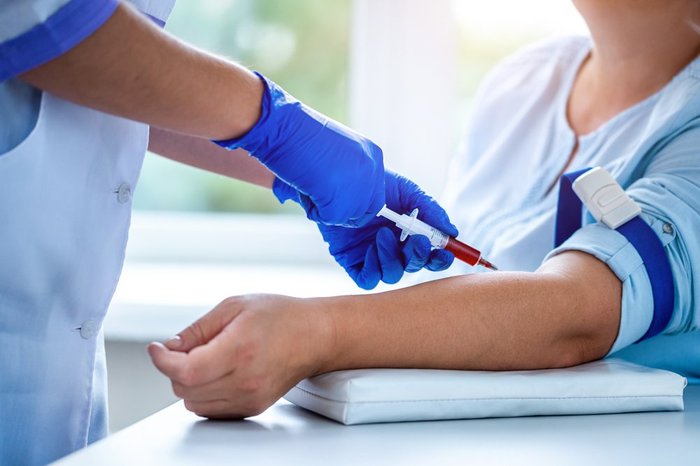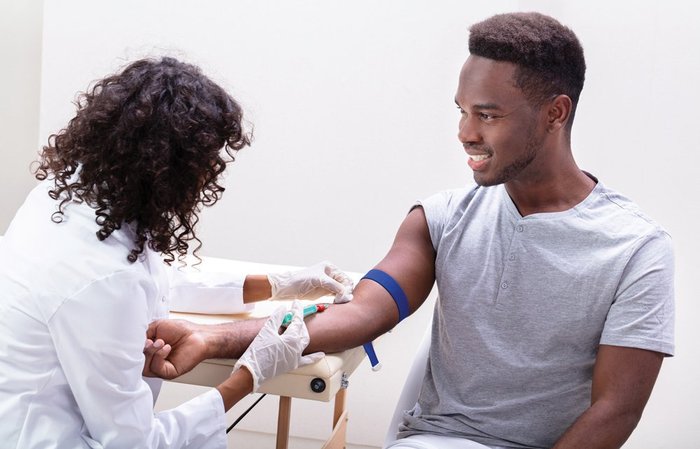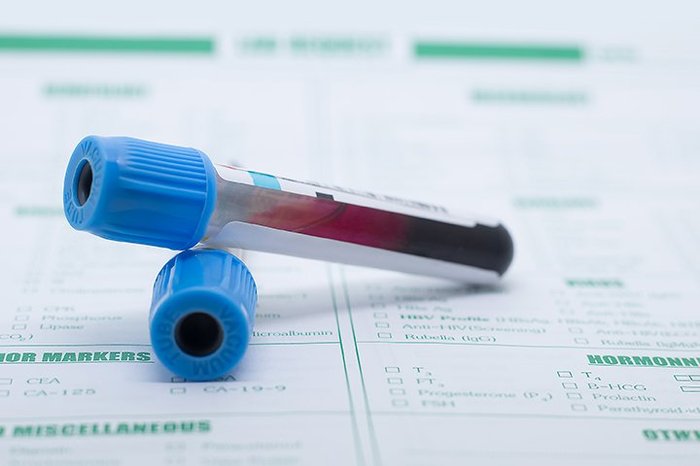When you are waiting for a kidney transplant, you have a lot of blood tests. These are essential to help decide whether you can accept a kidney from a particular deceased or living donor.
More than four in 10 people in the UK who are waiting for a transplant have been told that they have antibodies and that they are sensitised to many or most potential donors. What does this mean? How do you become sensitised? And what are the options for your transplant?
Kidney transplants: blood groups
The first blood test you have before you are listed for a transplant aims to see whether your blood group or type is compatible with a potential donor’s blood group. The four main blood groups that are important in transplantation are A, B, O and AB – these are known as the ABO system.
Your blood group is inherited from your parents.
In the UK, O is the most common blood group, followed by group A. The other blood groups are less common but are more likely to be present in people with a black or minority ethic heritage.
Donors with blood group O are known as universal donors because they can donate a kidney to people with any blood group.
People with blood group AB are universal recipients because they can receive a kidney from a donor in any other blood group.
Donating a kidney
- Blood group O can donate a kidney to blood group A, B, AB or O.
- Blood group A can donate a kidney to blood group A or AB.
- Blood group B can donate a kidney to blood group B or AB
- Blood group AB can donate a kidney to blood group AB.
Receiving a kidney
- Blood group O can receive a kidney from blood group O.
- Blood group A can receive a kidney from blood group A or O.
- Blood group B can receive a kidney from blood group B or O.
- Blood group AB can receive a kidney from blood group A, B, AB or O.
“Your blood group is identified by mixing the liquid part of your blood, called serum, with blood (i.e. red blood cells) that is known to be type A and type B. Antibodies in your blood react to proteins or antigens on these red cells to identify the blood group. Antibodies are part of the body’s natural defences: they recognise infections and other foreign invaders and alert the immune system to destroy them,” explains Mr Nicos Kessaris, a Consultant Transplant Surgeon at Guy’s and St Thomas’ NHS Foundation Trust (GSTT), London
"If your blood group is type A, you will have anti-B antibodies and if your blood group is type B, you will have anti-A antibodies. If your blood type is O, you will have both types of antibodies. Your blood group does not have to be exactly the same as your donor’s, but it must be ABO compatible to avoid rejection of the transplanted organ,”.

Kidney transplants: HLA matching
After checking for ABO compatibility, the next step is a blood test for tissue or human leukocyte antigen (HLA) typing.
Leukocyte is the scientific term for white blood cells and antigens are markers or proteins on the cells of the body that play an important role in the immune system.
You inherit your HLA from your parents, three (A, B, and DR) from your mother and three (A, B, and DR) from your father. The result is a total of six markers, which are identified by numbers. Your HLA type might be, for example:
- A3, A36
- B7, B27
- DR3, DR7
Tissue typing for kidney transplantation involves screening both your and your donor’s A, B and DR markers. Confusingly, the results are shown as the number of mismatches between donor and recipient.
This means that the worst HLA match is 2-2-2 (total = 6) and the best is 0-0-0 (total = 0).
“Even though HLA matching is still important, it has become less of an issue over the years. This is due to the stronger immunosuppression we have available now. As a result, we currently see less early or acute rejection, and better results at one year after a kidney transplant.” says Nicos.
The first reason for the continuing importance of HLA matching is that the closer the HLA match, the longer a kidney transplant is likely to last.
Looking at deceased-donor kidney transplants, for example, the Collaborative Transplant Study shows that on average, 45% of 0-0-0 mismatch kidneys are likely to last 20 years or more, compared with 31% of 2-2-2 mismatch kidneys.
“It’s important to remember that this research is just looking at the influence of HLA for deceased-donor kidney transplants. Other factors to take into consideration include any other health conditions you have, the quality of your donor kidney, and the age of your donor,” adds Nicos.
When it comes to living-donor transplants, a 0-0-0 mismatch living-donor kidney is likely to last longer than a less well-matched kidney from a living donor. Otherwise, matching appears to be less important than for deceased-donor transplants: research shows that a 2-2-2 mismatch living-donor kidney is likely to last at least as long as the best-matched 0-0-0 deceased-donor transplant.
“As doctors, we would always aim for the best HLA match between any recipient and their donor, especially for first kidney transplants. This is because the closer the match, the less likely you will develop antibodies and become sensitised, which will greatly limit your options for any future transplants,” continues Nicos.

Kidney transplants: sensitisation
We need antibodies to protect us against infections and other harmful invaders, but the immune system sees any foreign tissue or protein as a threat. Because of this, the body forms anti-HLA antibodies each time you are exposed to tissue or HLA types that are different from your own, including when you have an organ transplant, a blood transfusion, or a pregnancy.
The level of these antibodies can rise and fall, but once you have produced an antibody, you will get an increase in the level much faster the next time you are exposed to the same protein — just as a vaccine helps you to produce antibodies you need to fight an infection.
The risk of sensitisation is why the kidney allocation system prioritises HLA matching, especially for children who are likely to need more than one transplant in their lifetime.
Your degree of sensitisation is expressed as a percentage and the higher the percentage, the more you are sensitised. If your percentage is more than 85%, you are described as highly sensitised. This is why cross-matching is essential before your transplant can go ahead.
The cross-match test is performed by mixing a small amount of your blood with a small amount of your potential donor’s blood. If the bloods react against each other, this is a positive or reactive cross-match. A positive cross-match shows that the recipient’s immune system would most likely attack your donor’s kidney, causing rapid rejection and failure of your transplant.
The closer the match, the less likely you will develop antibodies and become sensitised
The link between a mismatched transplant and the risk of sensitisation raises the question of whether it makes sense to wait for the best-matched kidney. According to Nicos, this must be an individual decision – considerations might include your age and the age of your donor, the quality of the kidney, and how much longer you are likely to wait.
However, Nicos recommends balancing the advantages and disadvantages of accepting an offer against the risks of staying on dialysis.
“While there are drawbacks in accepting a mismatched transplant – or indeed a kidney from a less-than-perfect donor — the risks of staying on dialysis are likely to be higher, especially if you have diabetes.
“So, my advice is that it is not worth waiting too long. The next offer may be less favourable and the longer you wait, the older and possibly less fit you will become for the operation.”
UK Living Kidney Sharing Scheme and paired and pooled donation
People who have a living donor but who are ABO-incompatible or sensitised to their donor (HLA-incompatible) have the option of taking part in the UK Living Kidney Sharing Scheme. The scheme aims to achieve compatible transplants with other living donor-recipient pairs.
When two pairs are involved, it is called ‘paired’ donation, and more than two pairs is called a ‘pooled’ donation.
Compatible donor-recipient pairs who are aiming for a better HLA or age match may also take part.
Donor-recipient pairs may take part in an altruistic donor chain. When a person opts to donate anonymously to the national transplant list, the kidney is first offered to a high-priority recipient on the list. If there is no suitable recipient, the donor is registered into the Kidney Sharing Scheme.
Their donated kidney is allocated to a recipient in the scheme and, in turn, that recipient’s donor donates to another recipient, and so on. The chain ends when the last donor gives a kidney to a person on the national waiting list.
Living-donor kidney matching computer runs are performed four times a year. If the Kidney Sharing Scheme is not successful, and you are waiting a long time on the national transplant list, it is now possible to remove or suppress your antibodies. If successful, this will allow your living-donor transplant to go ahead.

ABO- and HLA-incompatible transplants
Antibody removal before an ABO- or HLA-incompatible kidney transplant is performed by either plasma exchange (also called plasmapheresis) or immunoadsorption, and must be carried out in a specialist transplant centre.
Both techniques are a little like dialysis, and you will need to have a line inserted if you do not already have a fistula or other dialysis access.
A machine called a blood-cell separator is used for plasma exchange. As its name suggests, the machine separates and removes the plasma part of your blood. The rest of your blood is returned to your body, and the plasma is replaced with albumin, a natural part of the blood.
Immunoadsorption is similar, but only the plasma goes through an adsorption column to remove specific antibodies. The blood, including the plasma, is then returned to your body.
“While immunoadsorption is selective, plasma exchange is non-selective and so removes some of the factors that help your blood to clot. This means that there is a higher risk of bleeding during your transplant surgery, and we may need to replace the clotting factors around the time of your operation. Otherwise, plasma exchange and immunoadsorption are generally well tolerated,” says Nicos.
Removing unwanted antibodies can give you the chance of a successful living-donor kidney transplant
Choice of treatment depends on the type of transplant and the level of your antibodies. Plasma exchange is generally used for HLA-incompatible transplantation and can also be used in ABO-incompatible transplantation if your antibody levels are low. Immunoadsorption is needed for ABO-incompatible transplantation, especially if your antibody levels are high. You will have your treatment in the days leading up to your transplant.
Treatment is usually carried out as an outpatient procedure, but you may need several sessions if your antibodies are high.
You will also be given medicines before your transplant to help reduce the risk of rejection. People receiving an ABO-incompatible transplant at GSTT are given rituximab, which reduces the number of white cells that make the antibodies. Rituximab is given as a single infusion into a vein two to four weeks before the transplant. If you are having an HLA-incompatible transplant, you will be given an injection of alemtuzumab under the skin during the operation, and a second dose on the day after your surgery.
You will need to take higher doses of immunosuppressant medicines than for a routine transplant. At GSTT, these medicines include tacrolimus and mycophenolate, which are started seven days before the transplant surgery to make sure that your blood levels of immunosuppressant are high enough before your operation takes place.
“Your surgery will be the same as for a routine kidney transplant, but the timing is different. On the day scheduled for your operation, we always check your antibody levels in the morning; this is in case your antibodies have risen and you need another treatment session before your and your donor’s operations take place in the afternoon,” says Nicos.
“So, if your antibodies do not come down, there is a risk that your transplant will have to be postponed until the next day to allow further antibody removal.”
After your transplant
If everything goes well, you will usually stay in hospital for about seven days after an incompatible kidney transplant. This is longer than for people who have a routine transplant, who go home after four to five days if there are no complications.
“We do not want to miss an episode of acute rejection due to rising antibody levels," Nico explains. "If this rejection going to occur, it is likely to take place around day five after your incompatible transplant and can be so severe that the kidney stops producing urine.
“But we can usually successfully treat this antibody-mediated rejection with plasma exchange and intravenous immunoglobulin (IVIG), or occasionally another medication called eculizumab.”
There is a higher risk of infection after an incompatible transplant, and Nicos advises his patients to report any concerns — for example, feeling unwell, having a temperature or a cough — as soon as possible. Otherwise, monitoring after you go home starts with clinic visits three times a week, which gradually become less frequent depending on your and your transplanted kidney’s health.
Nicos reports that results, such as kidney outcomes, after ABO-incompatible living-donor transplants at GSTT are comparable to those of routine living-donor kidney transplants. The rate of rejection is about 30% compared to 15-20% following compatible transplants.
Kidney outcomes after HLA-incompatible living-donor transplants are generally similar to outcomes following a deceased-donor kidney transplant and are comparable to other specialist centres around the world. Rejection rate is around 40%.
“We have much positive experience in ABO- and HLA-incompatible living-donor transplantation in the UK, but these transplants are still a lot riskier than routine kidney transplants," Nico concludes.
“So, we always advise incompatible living donors and recipients to first take part in the UK Kidney Sharing Scheme, and hopefully highly sensitised patients will have a better chance of a deceased-donor transplant, as they will be prioritised even further.
“But if you have exhausted these options, removing your unwanted antibodies can give you the chance of a successful living-donor kidney transplant.”